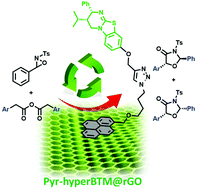Enantiopure isothiourea@carbon-based support: stacking interactions for recycling a lewis base in asymmetric catalysis†‡
Abstract
New procedures dedicated to the efficient reuse of chiral organic catalysts are currently in great demand. Indeed, and even if toxicity issues are less problematic than with organometallic catalysts, their easy recovery and recycling allow an overall saving of material, which is of utmost importance when valuable enantiopure catalysts are concerned. We describe here the synthesis of a chiral isothiourea (hyperBTM) functionalized by a pyrene moiety via click chemistry. This new enantiopure Lewis base is used as supported catalyst thanks to its immobilization on reduced graphene oxide via strong π–π interactions between the polyaromatic core and the carbon support. The synthesis of scalemic oxazolidin-4-ones from oxaziridines and arylacetic anhydrides is chosen as a test reaction to assess the validity of the process, this transformation having never been carried out under recycling conditions. Optimization of the reaction conditions led to the synthesis of the targeted products in high yields and good to excellent enantioselectivity values with the supported catalyst. Recovery of the active species occurred by simple filtration, the immobilized catalyst was then successfully reengaged in seven consecutive cycles while maintaining its efficiency. The robustness of this chiral organic isothiourea was also demonstrated in an original multi-substrate procedure.

- This article is part of the themed collection: 2021 Organic Chemistry Frontiers HOT articles


 Please wait while we load your content...
Please wait while we load your content...